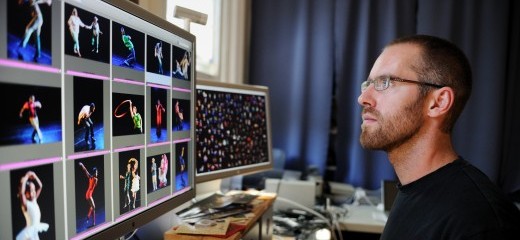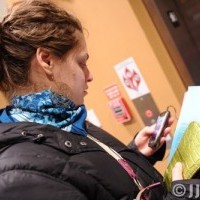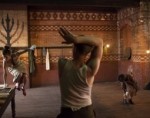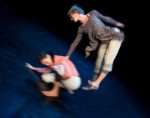
How JJ Moves
by Amelia Longo
Philadelphia’s JJ Tiziou is known for his vivid images of dance performances, as well as for his project How Philly Moves, which he describes as capturing the moves of “self-identified Philly dancers.” A selection drawn from thousands of his photos is now featured in one of the world’s largest murals on the Philadelphia Airport parking garages.
How do you distinguish between JJ as photographer, audience member, and dancer? Or do they always overlap?
Through about 2007, I always had a camera with me, and I’d photograph everything. A lot of great things come out of that overlap, and also challenges. It’s good to make some demarcations and say, “Here’s where I’m photographing a dance party, and here’s where I want to leave the camera and just dance.”
Sometimes I’ll still be photographing in my head. People see me chasing dancers and think the hard work is the running. The hard work is the observing, all the mental math of anticipating moments, seeing how things line up. There are times when I'll find myself slipping into that observer mindset, and I won’t be present as a dancer at the dance party, because I’ll be floating around outside my body, thinking that the shot is actually three feet to my left and six inches down. There’s definitely value in cultivating that separation, being present and being a dancer.
You dance on your own for fun, and sometimes even in people’s shows. Do you ever feel the pull of wanting to dance when you’re photographing?
I’m always dancing while I’m in photographer mode, but it’s definitely a different dance. One place where that’s different is when I'm more conscious of people watching me. For instance, I just had a cameo in a piece by Nicole Bindler and Gabrielle Revlock where they wanted me to jump on stage and run around photographing. At that point, I’m a performer, and I’m thinking about my movements as they’re seen, rather than [as movements] to make images. I’m taking pictures, but they’re not my strongest work. When I’m photographing a dance party, my movements will tune in to the music, and I’ll be doing my own funny dance, but it’s guided by where the camera needs to be.
You’ve been a professional photographer for almost 10 years, and your portfolio includes theatre, wedding, and even surgical photos. How did you get started taking pictures of dance, and how is photographing dance different from photographing other subjects?
I had friends who were dancers in undergrad, and they asked me to photograph some of their performances. Then I started photographing dance in social settings, sometimes at parties, then later on when photographing my friends’ weddings. In 2003 I got really involved in photographing the Fringe Festival in Philadelphia, which got me a little more plugged into the city's performing arts community. And then I started finding dance in a lot of other places, like protests. Dance is like most other things I photograph. It's maybe more challenging, because in the rest of the world, people’s movements are a bit more predictable. If they’re walking one way, they’re going to keep on walking that way, instead of walking that way and then half doing a roll backwards. There’s this funny dance between subject and background and light and space and photographer. That’s the little weaving and bobbing dance I do all the time, whether I’m photographing a development firm, or dancers on stage, or protesters in the street. All of it becomes about how all these things fit together to carve out a compelling two-dimensional composition out of a chaotic four-dimensional world. It's not always on stage; people don’t always know they’re dancers.
You say “Everyone can dance.” Still, have you ever been surprised by the dance you’ve seen?
The community outreach for How Philly Moves is a great reminder of how unknowable a city is. I'm familiar with Aztec dance from work I did in Florida and Chicago. In 2008, doing my first round of outreach, I was like, “I didn’t know we had that here.” Then in 2010, doing a little more research, I was like, “Wow, we have at least four companies doing Aztec dance.” And line dancing is this huge thing in Philly, but I never run into it, and I consider myself plugged into “the dance community.” It’s a much broader thing that none of us can know completely. Some of the dance for this round, I didn’t even know the words in the applicants’ descriptions. With people you aren’t used to working with and things you’re not familiar with, it’s a lot more challenging. But there’s potential for a lot of real beauty in that struggle, in getting to know people, being open to things that are different.
How Philly Moves dancers who aren’t in the airport mural showed up to support the dedication. How does this project create that connectedness?
It’s not creating connectedness; it’s reminding people of connectedness. I don’t make the people beautiful. I don’t make their dance beautiful. I’m just trying to remind them that they love to dance and are beautiful. The people represented on the mural were chosen because of formal color and shape constraints, and how their images fit on the wall, and we wanted both social and performative dancers. But every single person participating, and every person who didn’t participate, is a winner. This is not about idolizing a celebrity, but celebrating your community, your neighbors. And it’s not about competing, it’s about collaborating and showing everyone together. And I think that’s a recipe for awesome, so I’m not surprised people feel connected and stay involved.
Any last comments?
Everyone's photogenic.
Here's a preview of images from the most recent shoot.
By Amelia Longo
January 10, 2012







.png)


